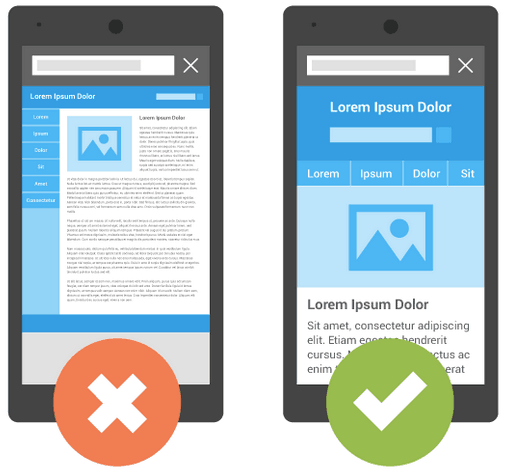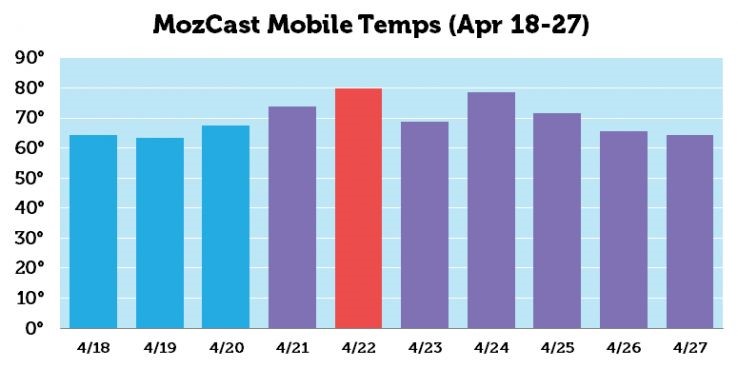On April 21, 2015, Google rolled out their mobile-friendly update, which quickly earned several monikers – mobilepocalyse, mopocalypse, mobocalypse, etc.
Ultimately the name that stuck was “Mobilegeddon” (as far as I can tell, credit for this one goes to Barry Schwartz at Search Engine Land) because SEO people are dramatic.
What Was Mobilegeddon?
Google posted this message on the official Webmaster Central Blog, as they sometimes do, and explained the update in brief detail accompanied by a picture to show the difference between what mobile-friendly was and wasn’t:

This update provided no gray area. Your pages were either mobile-friendly, or they weren’t. There was no in-between.
That day in April was the official rollout of the update but wasn’t the only notification that Google gave webmasters.
Mobilegeddon: It’s Closer Than You Think
On February 26, 2015, more than two months before the official rollout, Google posted a message telling us that they would be extending the use of mobile-friendliness as a ranking signal. This change was coming on April 21 and that we needed to prepare.
Google’s post started out by stating the reasoning behind the change:
“When it comes to search on mobile devices, users should get the most relevant and timely results, no matter if the information lives on mobile-friendly web pages or apps.”
In the April 21 post, Google gave a quick three bullet list of what this update would impact:
- Affects only search rankings on mobile devices.
- Affects search results in all languages globally.
- Applies to individual pages, not entire websites.
The change was straightforward and massive. Your pages were either mobile-friendly or they weren’t (a yes/no response) and it would impact everyone and roll out over the course of a week.
No matter what industry you were in, whether you sold soap or built bridges, your site would be impacted.
Google Goes Mobile-First
This was not just an algorithm update, it was a cultural shift, and Google was about to move the market.
A common misconception about Google is that they are obsessed with making search folks’ lives more difficult with changes like this. This, however, isn’t true.
Google is obsessed with improving the user experience as much as possible and aligning it with user behavior and trends in the market.
This update wasn’t really about organic search. It was about responding to consumer behavior, which was trending in the direction of mobile.
Google made a decision to pivot and adapt to consumer behavior. And it was the correct decision for Google.
Why does Google care so much about a user’s experience with their search engine? Mainly because the bulk of their revenue still comes from paid ads. They want to provide the best experience possible so people keep clicking on them and funding their free lunches and robotic dreams.
So far Google has been second to none in anticipating and pivoting to search trends. Google’s crystal ball is real, and it works.
Was Mobilegeddon’s Impact as Catastrophic as Predicted?
We were told the impact of the mobile-friendly update would be greater than Panda and Penguin.
But was it?
Not really.
In the days following the update, everyone in the industry began to slowly exhale and analyze how their sites fared through the week of the rollout. Once the dust settled it appeared that the answer to the question of the updates impact was, “meh”, accompanied by shoulder shrugs all around.
For the most part, experts said that the update worked just as it was intended to. Non-mobile friendly pages were negatively impacted in mobile search and began to fall in the SERPs.
Moz’s Dr. Pete Meyers did a great write up on the impact you can read here that shows the slight impact before and after the update.
Since MozCast only tracked desktop temperatures at that time, Moz actually built MozCast Mobile because of this update to track how it impacted sites. Throughout the entire analysis, Dr. Pete breaks down various factors and data points that he was tracking, but this excerpt describing the graph to the right paints the best picture of the overall impact:

“Across the board, mobile temperatures run a little hotter (which could just be quirks in how we measure). On April 21st, mobile temps were slightly higher, but nothing to write home about. So far, Day 2 (April 22nd) has shown the hottest temperatures, hitting 79.8°F. Interestingly, the difference between desktop and mobile flux was almost 18° on Day 2. There’s another small spike on April 24th, but as you can see from the first graph, that spike also impacted desktop rankings. Whatever happened that day doesn’t appear to be related to any kind of mobile algorithm update.”
Colin Guidi of 3Q digital also had an interesting analysis that stated site speed and load times had a larger impact on rankings than mobile-friendliness:
“Visiting these sites via a mobile browser and slower processors shows that page speed and load time seems to be a heavier weighted ranking factor over this new mobile-friendly update. With responsive sites you have a heavier code base and can inherently have a slower load time while still passing Google’s Mobile Friendly Test. Responsive sites that fall into this bucket of being friendly but still outranked by non-mobile-friendly sites should take a look at their TTFB (time to first byte).”
It was an interesting point of view at the time, as page speed and load times had just started to enter mainstream conversations as major ranking factors. This was probably the beginning of the shift in folks’ mindsets towards a faster experience equaling better results. You wonder if Google baked that in as part of this update as well, but there is no data supporting that theory.
These analyses, along with many others, confirmed what most were seeing: there wasn’t that much of a traffic and ranking impact at all.
Overall, this became a headscratcher for a lot of search marketers, because most folks weren’t seeing a measurable impact. Of course, there were some outliers who got hit and took to the message boards to curse Google’s name to the depths of hell. However, for the most part, this update didn’t produce huge ranking shifts across the board, which in retrospect, is probably what Google wanted all along.
This was one of the first updates that Google gave folks a full explanation of what was happening, when it was happening, and how long it would take to roll out.
While this update was certainly about pushing people to go mobile-friendly, it more than likely was also a test to see how they could impact change by giving folks information to act on before an update hit, so that minimal impact, and complaining, followed.
Google had given folks time to make changes and create some form of mobile-friendly version of their pages, which resulted in a better user experience for their users and fewer issues with the search community.
No one could really complain because nothing catastrophic really happened. This wasn’t Mobilegeddon, it was more of a mobile speed bump that, for the most part, everyone got over just fine.
As time went on more sites became mobile-friendly, which in turn resulted in a better web experience for users, overall, not just for folks in the industry, but everyone, everywhere.
Google had used this update as a delivery mechanism for a much larger initiative, to get large amounts of sites to change their design and how they think about the web in a short period of time.
How did they get people to do that?
Google hung the biggest carrot they could to garner interest – a ranking boost – which they announced in that blog post in February and set everyone off to chase after it.
It worked quite well.
Good for Google to recognize the coming change in the industry and helping people move towards. While Mobilegeddon didn’t have a big ranking and traffic impact, it certainly had a user experience and cultural impact that benefitted everyone.
Additional Reading:
- Mobilegeddon is Here: Google’s Mobile-Friendly Algorithm is Live!
- Worldwide Reaction to #Mobilegeddon
Mobilegeddon 2.0
About a year later, on March 16, 2016, Google announced that they would be strengthening their mobile-friendly ranking signal in early May and giving a stronger ranking boost to those who complied.
Google’s official post started off in a very similar way that the original post:
“Getting good, relevant answers when you search shouldn’t depend on what device you’re using. You should get the best answer possible, whether you’re on a phone, desktop or tablet. Last year, we started using mobile-friendliness as a ranking signal on mobile searches. Today we’re announcing that beginning in May, we’ll start rolling out an update to mobile search results that increases the effect of the ranking signal to help our users find even more pages that are relevant and mobile-friendly.”
Google was doubling down on the ranking boost that mobile-friendly pages received.
On May 12th John Mueller announced on Twitter that, “The mobile changes mentioned here are now fully rolled out.” Also, if you were already mobile-friendly, “you will not be impacted by this update.”
When asked if this was Mobilegeddon 2, John responded, “No, not really.”

The rollout of the second iteration was interesting in a few ways.
When you think and see how visceral the reactions were to every Panda and Penguin update (some with very good reason) it’s amazing to see how calm the industry reacted to both iterations of this update.
There were threads where people were discussing, arguing, and complaining about the update, but it wasn’t as angry a reaction. It was a more composed chaos – in stark contrast to the usual Armageddon (see what I did there?) that typically ensues.
It was the first time that I saw grown adults not have meltdowns on message boards, but rather, were asking questions and sharing knowledge of what was working and not working for their mobile experiences.
That can be attributed to Google giving folks enough time to prepare and giving clear direction on what the update was, when it was happening, and how it was going to work. These updates also had the benefit of their effect coming into play as a yes/no response, which just about every other update doesn’t have, so it was easier for folks to identify and accommodate the change.
After all was said and done, this was a positive step for Google and the search industry.
The Legacy of Mobilegeddon
In the end, Google both proved and learned a few things were possible with this update:
- They can enact change beyond traffic and rankings, and get people to change how they design their sites to accommodate the market.
- Not every algorithm update has to be a confusing mess to understand.
- When you give people enough time to prepare and understand a change is coming, you can avoid inciting a riot.
The first and third points on that list are the two most important to note. This update was a big step forward for Google both in how they communicated with our industry and the types of change they can influcence impact upon.
To this day this was probably the smoothest and most successful rollout that Google has done regarding their algorithm updates.
What’s Next?
Google’s mobile-friendly update laid the foundation for all other tweaks and updates to the mobile SERPs. It solved the problem of getting people to invest dollars into their site to make them mobile-friendly, and set the tone for our industry moving forward:
If you aren’t mobile-friendly, you aren’t allow to hang out here anymore.
Looking ahead, this was the precursor to the impending mobile-first indexing initiative Google will someday soon roll out to the world, which will solidify the mobile experience.
While the impact of this update, in the traditional sense, may have been small, this was by far one of the most important milestones in the history of Google’s algorithms.
Image Credits
Featured Image: Shutterstock, modified by Danny Goodwin
Screenshots taken by author





